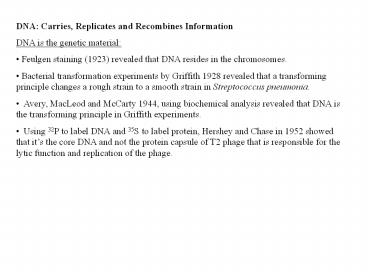DNA: Carries, Replicates and Recombines Information - PowerPoint PPT Presentation
1 / 23
Title:
DNA: Carries, Replicates and Recombines Information
Description:
DNA: Carries, Replicates and Recombines Information DNA is the genetic material: Feulgen staining (1923) revealed that DNA resides in the chromosomes. – PowerPoint PPT presentation
Number of Views:92
Avg rating:3.0/5.0
Title: DNA: Carries, Replicates and Recombines Information
1
- DNA Carries, Replicates and Recombines
Information - DNA is the genetic material
- Feulgen staining (1923) revealed that DNA
resides in the chromosomes. - Bacterial transformation experiments by Griffith
1928 revealed that a transforming principle
changes a rough strain to a smooth strain in
Streptococcus pneumonia. - Avery, MacLeod and McCarty 1944, using
biochemical analysis revealed that DNA is the
transforming principle in Griffith experiments. - Using 32P to label DNA and 35S to label
protein, Hershey and Chase in 1952 showed that
its the core DNA and not the protein capsule of
T2 phage that is responsible for the lytic
function and replication of the phage.
2
(No Transcript)
3
(No Transcript)
4
- The Watson and Crick Model of DNA
- The double helix model of DNA proposed by Watson
and Crick depends on the following findings - Rosalind Franklin and Maurice Wilkins in 1952
reported that the crosswise pattern of X-ray
diffraction of DNA fibers indicates a helical
structure for DNA - Erwin Chargaff by analyzing the base
composition of DNA extracted from different
organisms that A T and G C and that (A
G)/(CT) 1. - Hence the Watson Crick model is
- DNA is a right handed double helix, with sugar
and phosphate being the core and the nitrogenous
bases forming the steps of the ladder (G is
complementary to C and T complementary to A - Hydrogen bonds 3 between G C and 2 between A
T. - 3.4 Angstrom between two nucleotides in a single
strand and 34 Angstrom every complete turn of the
helix - The two strands of the helix are 20 Angstrom
apart - major groove and a minor groove alternate
5
(No Transcript)
6
(No Transcript)
7
(No Transcript)
8
(No Transcript)
9
(No Transcript)
10
- RNA differs from DNA in
- ribose instead of deoxyribose
- uracil instead of thymine
- single strand instead of double strand. The
single strand forms double strand areas by
twisting upon itself using the same rules of base
complementarity (A complementary to U and G
complementary to C) - RNA is transcribed off DNA and functions as a
mediator in gene expression protein synthesis - Some viruses have RNA as their genetic material
but during infection the RNA has to revert back
to its complementary DNA (cDNA) to cause
successful infection.
11
(No Transcript)
12
- DNA Replication
- Semiconservative as proposed by Watson and Crick
in their 1953 paper on DNA structure then proved
by Meselson and Stahl in 1958 - DNA replication in prokaryotes includes
1) Single
origin of replication
2) Initiator
protein recognizes and binds at the origin of
replication and attracts a DNA helicase to bind
3)
DNA helicase catalyzes the unwinding of the
double helix 4) Primase synthesize a
short RNA primer to initiate polymerization by
DNA polymerase III
5) Elongation in the 5 ---gt 3
direction in both the leading strand (continuous
synthesis) and the lagging strand (discontinuous
synthesis) at each replication fork
6) DNA
polymerase I digests the RNA primer and at the
same time fills in the gap with DNA synthesis in
the 5 to 3 direction.
13
- 7) DNA ligase catalyzes the formation of the
final phosphoester bond and close the nick in the
DNA strand. - 8) The primary DNA repair enzyme is DNA
polymerase I but DNA polymersae II can serve as
an alternate repair polymerase and can replicate
DNA under circumstances in which the template is
damaged. - 9) DNA topoisomerases relax the supercoils formed
beyond the replication fork by introducing a cut
in the double helix. The cut strands rotate to
unwind and then rejoin (Phosphoester bond) by a
DNA ligase. - In eukaryotes, the mechanism of DNA replication
is similar except that there are multiple origins
of replications and there are five DNA
polymerases involved, ?, ?,?,? and ?. DNA
polymerase ? is in charge of chromosomal
replication (lagging leading strands), ? for
the lagging strand and ? for repair of nuclear
DNA.
14
(No Transcript)
15
(No Transcript)
16
(No Transcript)
17
(No Transcript)
18
(No Transcript)
19
(No Transcript)
20
(No Transcript)
21
(No Transcript)
22
(No Transcript)
23
(No Transcript)































